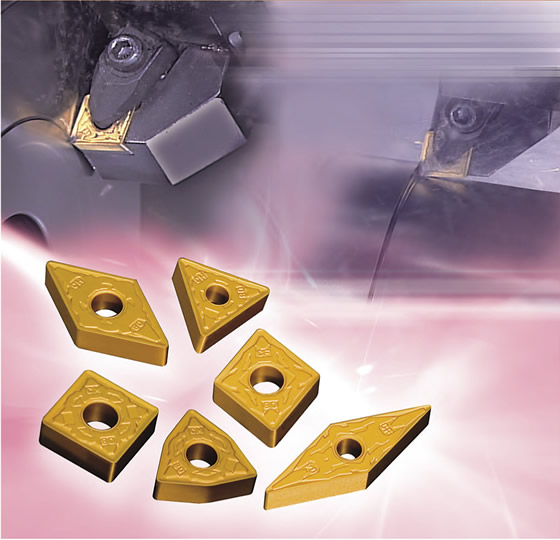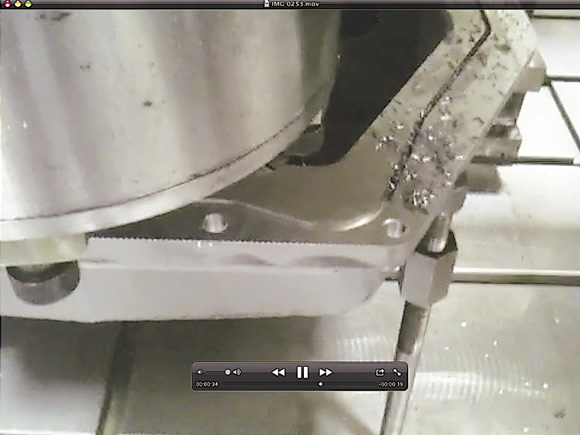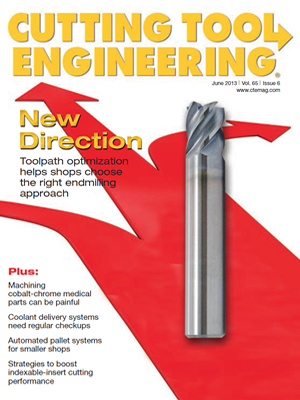END USER: SFI, (901) 363-1571, www.sfifab.com.
CHALLENGE: Reduce cycle time when slot milling an A-36 steel part.
SOLUTION: A 4-flute, solid-carbide endmill for roughing and finishing in one pass at full slot width and depth.
SOLUTION PROVIDER: Iscar Metals Inc., (877) BY-ISCAR, www.iscarmetals.com.
A shop’s standard, go-to cutting tool is subject to change when a better one comes along. SFI, Memphis, Tenn., realized this when cutting a 382 "-long × 0.25 "-wide × 0.253 "-deep slot in an A-36 steel oil pan. The company, which also has a facility in Conway, Ark., designs, develops, supplies and services medium- to heavy-gauge components for OEMs in the agricultural, construction, industrial, transportation and defense industries.

When slotting the first four prototypes of the oil pan, SFI was applying its then-standard ¼ "-dia., full-radius, 4-flute, solid-carbide endmill. Run on an SNK RB-4VM 5-axis gantry mill with a 6m × 2m table, the machining parameters were a 160-sfm cutting speed, 2,443-rpm spindle speed, 5.86-ipm feed rate, 0.0006-ipt feed per tooth, 0.25 " WOC and 0.05 " DOC. Average thickness for the fragment-type chips was 0.0006 ", the metal-removal rate was 0.07 in.3/min. and each cutter lasted one part, with flank wear being the predominant type of wear.
When run at the full slot depth on the oil pan job, the standard endmill snapped, causing rework, noted Matt Watts, machine shop supervisor. Using trial and error, SFI backed the tool off so it could get through the part, but the cycle time consumed about 6.5 hours. When extrapolated for the proposed 100-piece run for the family of oil pans, total cutting time would have consumed an unacceptable 651.6 hours, according to Watts.
Fortunately, Watts and Greg Archer, SFI programmer, attended a seminar presented by Iscar Metals Inc. at the toolmaker’s headquarters in Arlington, Texas. They asked Rex Luxmore, Iscar’s sales engineer for western Tennessee, if the FINISHRED solid-carbide endmill they saw demonstrated at the event was suitable for the oil pan application. “I said, ‘Hell yeah, that’s perfect for it,’” Luxmore recalled.

An Iscar ¼ " solid-carbide FINISHRED endmill reduced cycle time from more than 6.5 hours to 8 minutes when slotting an A-36 steel oil pan at SFI.
SFI then tested an Iscar ¼ "-dia., 4-flute, solid-carbide FINISHRED endmill, the EFSI-E44 250-500C250CF2.5, and another toolmaker’s ¼ ", 4-flute, solid-carbide endmill. The Iscar “chatter-free” endmill has two finishing flutes that extend slightly farther than the tool’s two roughing flutes, so it simultaneously roughs and finishes a workpiece. “It leaves a beautiful finish,” Luxmore said, adding that there’s no specified surface finish. “It looked like an easy win for me.”
And it was. Although the other tool tested reduced cycle time by more than half, the Iscar endmill reduced it by more than 97 percent. “It was done in 8 minutes,” Luxmore said, “and they couldn’t believe it.”
Luxmore added that the air blowing beside the machine spindle—instead of coolant—is effective for evacuating the comma-shaped chips FINISHRED endmills produce. Coolant usually pushes the chips back down, and air blows them out, he noted.
According to the test results, the Iscar endmill slotted the 382 " length at a 300-sfm cutting speed, 4,580-rpm spindle speed, 36.64-ipm feed rate, 0.002-ipt feed per tooth, 0.25 " WOC and full DOC of 0.253 ". Average chip thickness was 0.002 ", the mrr was 2.32 in.3/min. and each cutter lasted two parts, with flank wear also being the predominant type of wear.
Although the FINISHRED endmill costs nearly 2.5 times as much as the one originally applied, the longer tool life and, more importantly, the vastly enhanced productivity achieved a projected cost reduction of $80,828 per 100-part batch based on a $128 machine cost per hour compared to the full-radius endmill. Looking at the tooling and time cost per part, the Iscar tool reduced costs by 94.5 percent.
SFI is in the early stages of production for the oil pan and expects to have an on-going order of 100 parts per year, according to Watts.
“Once we get into full production, we will more than likely try to push the tool a little harder,” he said, noting the machine tool is running close to its maximum spindle speed. “The Iscar tool has become the standard for just about everything we’re doing.”
Related Glossary Terms
- coolant
coolant
Fluid that reduces temperature buildup at the tool/workpiece interface during machining. Normally takes the form of a liquid such as soluble or chemical mixtures (semisynthetic, synthetic) but can be pressurized air or other gas. Because of water’s ability to absorb great quantities of heat, it is widely used as a coolant and vehicle for various cutting compounds, with the water-to-compound ratio varying with the machining task. See cutting fluid; semisynthetic cutting fluid; soluble-oil cutting fluid; synthetic cutting fluid.
- cutting speed
cutting speed
Tangential velocity on the surface of the tool or workpiece at the cutting interface. The formula for cutting speed (sfm) is tool diameter 5 0.26 5 spindle speed (rpm). The formula for feed per tooth (fpt) is table feed (ipm)/number of flutes/spindle speed (rpm). The formula for spindle speed (rpm) is cutting speed (sfm) 5 3.82/tool diameter. The formula for table feed (ipm) is feed per tooth (ftp) 5 number of tool flutes 5 spindle speed (rpm).
- endmill
endmill
Milling cutter held by its shank that cuts on its periphery and, if so configured, on its free end. Takes a variety of shapes (single- and double-end, roughing, ballnose and cup-end) and sizes (stub, medium, long and extra-long). Also comes with differing numbers of flutes.
- feed
feed
Rate of change of position of the tool as a whole, relative to the workpiece while cutting.
- flank wear
flank wear
Reduction in clearance on the tool’s flank caused by contact with the workpiece. Ultimately causes tool failure.
- flutes
flutes
Grooves and spaces in the body of a tool that permit chip removal from, and cutting-fluid application to, the point of cut.
- gang cutting ( milling)
gang cutting ( milling)
Machining with several cutters mounted on a single arbor, generally for simultaneous cutting.
- metal-removal rate
metal-removal rate
Rate at which metal is removed from an unfinished part, measured in cubic inches or cubic centimeters per minute.
- milling
milling
Machining operation in which metal or other material is removed by applying power to a rotating cutter. In vertical milling, the cutting tool is mounted vertically on the spindle. In horizontal milling, the cutting tool is mounted horizontally, either directly on the spindle or on an arbor. Horizontal milling is further broken down into conventional milling, where the cutter rotates opposite the direction of feed, or “up” into the workpiece; and climb milling, where the cutter rotates in the direction of feed, or “down” into the workpiece. Milling operations include plane or surface milling, endmilling, facemilling, angle milling, form milling and profiling.
- milling machine ( mill)
milling machine ( mill)
Runs endmills and arbor-mounted milling cutters. Features include a head with a spindle that drives the cutters; a column, knee and table that provide motion in the three Cartesian axes; and a base that supports the components and houses the cutting-fluid pump and reservoir. The work is mounted on the table and fed into the rotating cutter or endmill to accomplish the milling steps; vertical milling machines also feed endmills into the work by means of a spindle-mounted quill. Models range from small manual machines to big bed-type and duplex mills. All take one of three basic forms: vertical, horizontal or convertible horizontal/vertical. Vertical machines may be knee-type (the table is mounted on a knee that can be elevated) or bed-type (the table is securely supported and only moves horizontally). In general, horizontal machines are bigger and more powerful, while vertical machines are lighter but more versatile and easier to set up and operate.
- sawing machine ( saw)
sawing machine ( saw)
Machine designed to use a serrated-tooth blade to cut metal or other material. Comes in a wide variety of styles but takes one of four basic forms: hacksaw (a simple, rugged machine that uses a reciprocating motion to part metal or other material); cold or circular saw (powers a circular blade that cuts structural materials); bandsaw (runs an endless band; the two basic types are cutoff and contour band machines, which cut intricate contours and shapes); and abrasive cutoff saw (similar in appearance to the cold saw, but uses an abrasive disc that rotates at high speeds rather than a blade with serrated teeth).
- slotting
slotting
Machining, normally milling, that creates slots, grooves and similar recesses in workpieces, including T-slots and dovetails.


